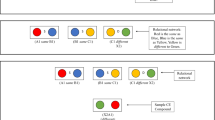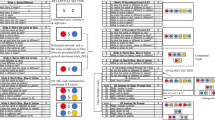Abstract
Participants were four 14-year-old adolescent boys with diagnosed autism spectrum disorder and 3 children without diagnosed learning disorders aged 5 to 11. Training trials to establish more/less relational functions for 2 stimuli (X and Y, respectively) were interspersed with training trials to establish comparative relations among 5 other arbitrary stimuli (i.e., A is more than B, B is more than C, C is more than D, and D is more than E). Subsequent tests showed a derived transformation of functions for 7 participants (i.e., derived more/less mands). Exemplar training was required with 2 children. An ABA design with 3 participants showed manding was controlled by trained relations.
Similar content being viewed by others
References
American Psychiatric Association. (2000). Diagnostic and statistical manual of mental disorders (4th ed.). Washington, DC: Author.
BARNES, D., BROWNE, M., SMEETS, P., & ROCHE, B. (1995). A transfer of functions and a conditional transfer of functions through equivalence relations in three to six-year-old children. The Psychological Record, 45, 405–430.
BARNES-HOLMES, Y., BARNES-HOLMES, D., ROCHE, B., & SMEETS, P. M. (2001a). Exemplar training and a derived transformation of functions in accordance with symmetry: I. The Psychological Record, 51, 287–308.
BARNES-HOLMES, Y., BARNES-HOLMES, D., ROCHE, B., & SMEETS, P. M. (2001b). Exemplar training and a derived transformation of functions in accordance with symmetry: II. The Psychological Record, 51, 589–604.
DOUGHER, M. J., AUGUSTON, E., MARKHAM, M. R., GREENWAY, D. E., & WULFERT, E. (1994). The transformation of eliciting functions through stimulus equivalence classes. Journal of the Experimental Analysis of behavior, 62, 331–351.
DYMOND, S., & BARNES, D. (1994). A transfer of self-discrimination response functions through equivalence relations. Journal of the Experimental Analysis of Behavior, 62, 251–267.
DYMOND, S., & BARNES, D. (1995). A transformation of self-discrimination response functions in accordance with the arbitrarily applicable relations of sameness, more-than, and less-than. Journal of the Experimental Analysis of Behavior, 64, 163–184.
GREEN, G., STROMER, R., & MACKAY, H. A. (1993). Relational learning in stimulus sequences. The Psychological Record, 43, 599–615.
HAYES, S. C., BARNES-HOLMES, D., & ROCHE, B. (2001). Relational Frame Theory: A post-Skinnerian account of language and cognition. New York: Plenum.
LARAWAY, S., SNYCERSKI, S., MICHAEL, J., & POLING, A. (2003). Motivating operations and terms to describe them: Some further refinements. Journal of Applied Behavior Analysis, 36, 407–414.
LUCIANO, C. M. S., BARNES-HOLMES, Y., & BARNES-HOLMES, D. (2001). Early verbal developmental history and equivalence relations. International Journal of Psychology and Psychological Therapy, 1, 137–149.
MICHAEL, J. (1993). Establishing operations. Behavior Analyst, 16, 191–206.
MURPHY, C., & BARNES-HOLMES, D. (2009a). Establishing derived manding for specific amounts with three children: An attempt at synthesizing Skinner’s Verbal behavior with Relational Frame Theory. The Psychological Record, 59, 75–92.
MURPHY, C., & BARNES-HOLMES, D. (2009b). Derived more/less relational mands with children diagnosed with autism. Journal of Applied Behavior Analysis, 42, 252–268.
MURPHY, C., BARNES-HOLMES, D., & BARNES-HOLMES, Y. (2005). Derived manding with seven children diagnosed with autism: Synthesizing Skinner’s verbal Behavior with Relational Frame Theory. Journal of Applied Behavior Analysis, 38, 445–462.
PILGRIM, C., CHAMBERS, L., & GALIZIO, M. (1995). Reversal of baseline relations and stimulus equivalence: Ii. Children. Journal of the Experimental Analysis of behavior, 63, 239–254.
PILGRIM, C., & GALIZIO, M. (1995). Reversal of baseline relations and stimulus equivalence: I. Adults. Journal of the Experimental Analysis of behavior, 63, 225–238.
REHFELDT, R. A. & ROOT, S. L. (2005). Establishing derived requesting skills in adults with severe developmental disabilities. Journal of Applied Behavior Analysis, 38, 101–105.
ROCHE, B., & BARNES, D. (1995). The establishment and electrodermal assessment of conditioned sexual responses. Experimental Analysis of Human Behavior Bulletin, 13, 26–29.
ROSALES, R., & REHFELDT, R. A. (2007). Contriving transitive conditioned establishing operations to establish derived manding skills in adults with severe developmental disabilities. Journal of Applied Behavior Analysis, 40, 105–121.
SIDMAN, M. (1971). Reading and auditory-visual equivalences. Journal of Speech and Hearing Research, 14, 5–13.
SKINNER, B. F. (1957). Verbal behavior. Englewood Cliffs, NJ: Prentice Hall.
STEELE, D., & HAYES S. C. (1991). Stimulus equivalence and arbitrarily applicable relational responding. Journal of the Experimental Analysis of behavior, 56, 519–555.
SUNDBERG, M. L., & MICHAEL, J. (2001). The benefits of Skinner’s analysis of verbal behavior for children with autism. Behavior Modification, 5, 698–724.
WHELAN, R., BARNES-HOLMES, D., & DYMOND, S. (2006). The transformation of consequential functions in accordance with the relational frames of more-than and less-than. Journal of Experimental Analysis of behavior, 86, 317–335.
Author information
Authors and Affiliations
Corresponding author
Additional information
The current study was partially funded by the Research and Graduate Studies Department at NUI Maynooth. Partial funding was also provided by the Irish Council for Research in the Humanities and Social Sciences.
We express our appreciation to the following people for their cooperation and assistance throughout the current research: Mark Ryan, Niamh Lane Kelly, and teachers who functioned as second investigators at a remedial unit that facilitated the current research.
Rights and permissions
About this article
Cite this article
Murphy, C., Barnes-Holmes, D. Establishing Complex Derived Manding with Children with and Without A Diagnosis of Autism. Psychol Rec 60, 489–503 (2010). https://doi.org/10.1007/BF03395723
Published:
Issue Date:
DOI: https://doi.org/10.1007/BF03395723




